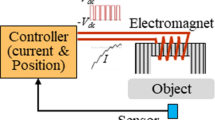Abstract
Giant magnetostrictive actuators (GMAs) often work in a close-loop feedback system. This system needs independent sensors which may be difficult to be fixed, besides, excessive sensors may cause more unpredicted problems in a large system. This paper aims to develop a self-sensing GMA. An observer based on piezomagnetic equations is constructed to estimate the stress and strain of the magnetostrictive material. The observer based self-sensing approach depends on the facts that the magnetic field is controllable and that the magnetic induction is measurable. Aiming at the nonlinear hysteresis in magnetization, a hysteresis compensation observer based on Preisach model is developed. Experiment verified the availability of the observer approach, and the hysteresis compensation observer has higher tracking precision than linear observer for dynamic force sensing.
Similar content being viewed by others
References
Clephas, B., Janocha, H., 1998. Simultaneous sensing and actuation of a magnetostrictive transducer. Proceedings of SPIE, 3329:174–184. [doi:10.1117/12.316891]
Davino, D., Natale, C., Pirozzi, S., 2005. A fast compensation algorithm for real-time control of magnetostrictive actuators. Journal of Magnetism and Magnetic Materials, 290–291:1351–1354. [doi:10.1016/j.jmmm.2004.11.435]
Engdahl, G., 2000. Handbook of Giant Magnetostrictive Materials. Academic Press, Sa Diego.
Jia, Z.Y., Yang, X., Guo, D.M., Guo, L.S., 2002. Study on control methods of microdisplacement actuator on giant magnetostrictive materials. Chinese Journal of Scientific Instrument, 23(3):288–301.
Jones, L.D., Garcia, E., 1997. Novel approach to self-sensing actuation. Proceedings of SPIE, 3041:305–314. [doi:10.1117/12.275655]
Kuhnen, K., Janocha, H., Schommer, M., 2004. Exploitation of Inherent Sensoreffects in Magnetostrictive Actuators. Proc. 9th International Conference on New Actuators, p.367–370.
Kuhnen, K., Schommer, M., Janocha, H., 2007. Integral feedback control of a self-sensing magnetostrictive actuator. Journal of Smart Materials and Structures, 16(4):1098–1108. [doi:10.1088/0964-1726/16/4/019]
Pratt, J., Flatau, A.B., 1993. Development and analysis of a self-sensing magnetostrictive actuator design. Proceedings of SPIE, 1917:952–961. [doi:10.1117/12.152827]
Restorff, J.B., Savage, H.T., Clark, A.E., 1990, Preisach modeling of hysteresis in Terfenol. J. Appl. Phys., 67(9):5016–5018.
Tang, Z.F., Lv, F.Z., Xiang, Z.Q., 2007. Hysteresis model of magnetostrictive actuators and its numerical realization. Journal of Zhejiang University SCIENCE A, 8(7):1059–1064. [doi:10.1631/jzus.2007.A1059]
Author information
Authors and Affiliations
Corresponding author
Additional information
Project supported by the National Natural Science Foundation of China (No. 50105019) and the China Postdoctoral Science Foundation (No. 20060390337)
Rights and permissions
About this article
Cite this article
Tang, Zf., Lv, Fz. & Xiang, Zq. Theory and experiment of observer based magnetostrictive self-sensing actuator. J. Zhejiang Univ. Sci. A 9, 99–103 (2008). https://doi.org/10.1631/jzus.A071402
Received:
Accepted:
Published:
Issue Date:
DOI: https://doi.org/10.1631/jzus.A071402




